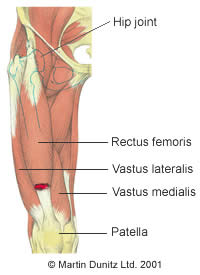Thigh Muscle Strain in Depth
| Common Signs & Symptoms | |||||
| Pain | Swelling | Stiffness | Weakness | Instability | Locking |
Thigh Muscle Strain Injury Explained
A Thigh muscle strain is quite common in sports like football, where kicking is repeatedly practiced. Cycling, rowing and downhill running are some other activities where the Quadriceps can become overloaded and susceptible to injury. A Thigh muscle strain refers to a tear in the Quadriceps muscle group. The Quadriceps are located at the front of the thigh and are responsible for extending (straightening) the knee. The Quadriceps group is made up of four muscles: Rectus Femoris, Vastus Lateralis, Vastus Intermedius and Vastus Medialis.

Usually, the muscle is forcibly stretched beyond its limits and the muscle tissue becomes torn during an activity such as sprinting or kicking a ball. A tear in a Thigh muscle is referred to as a Thigh strain and depending on its severity it is classified as a first, second or third degree strain:
- a first degree strain is damage to a few muscle fibres
- a second degree strain is damage to a more extensive number of muscle fibres
- a third degree strain is a complete rupture of the muscle itself
Thigh Muscle Strain Signs & Symptoms
With a grade one Thigh strain the signs may not be present until after the activity is over. There may be a sensation of cramp or Thigh tightness and a slight feeling of pain the next morning or when the muscles are stretched or contracted.
With a grade two Thigh strain there is immediate pain which is more severe than the pain of a grade one injury and it will make the individual “stop dead” in the activity to protect themselves from a complete rupture. There is pain on walking and the injury will be confirmed by pain on stretch and contraction of the muscle. A grade two Thigh strain is usually sore to touch and some bruising and swelling will be present.
A grade three Thigh strain is a complete rupture of a muscle and is a serious injury. There is immediate burning or stabbing pain and the athlete is unable to walk without pain. Often there is a depression in the thigh at the location of the tear and a lump above the depression. After a few days with grade two and three injuries a large bruise will appear below the injury site caused by bleeding within the tissues.
Thigh Muscle Strain Treatment
What you can do
| Consult a sports injury expert | |
| Apply ice packs to relieve pain | |
| Apply compression bandage to control bleeding & swelling | |
| Use resistance bands for muscle strengthening exercises | |
| Wear Compression Shorts or Thigh Support for reassurance during rehabilitation |
The immediate treatment for a Thigh muscle injury consists of rest, ice, and compression (never apply ice directly to the skin). This is aimed at reducing the bleeding and damage within the muscle tissue. Resting may be the common sense approach, but it is one that is often ignored by competitive athletes. This is unwise, since it does not take much to turn a grade one Thigh strain into a grade two, or a grade two Thigh strain into a grade three. As a general rule, grade one Thigh strains should be rested from sporting activity for about 3 weeks, and grade two Thigh strains for about 4 to 6 weeks. In the case of a complete rupture the Thigh muscle will have to be repaired surgically and the rehabilitation afterwards will take about 3 months.
Regardless of the severity of the Thigh injury, the treatment in the early stages is the same. The thigh should be rested in an elevated position, with an Ice Pack applied for twenty minutes every two hours, and a Compression Bandage applied. This should help to limit bleeding and swelling in the tissues. After the early days have been spent resting more active rehabilitation can be started. Compression Shorts can also be used to help support the affected area.
Gentle resistance exercises and thigh stretching are important as they help to align the scar tissue that forms during the healing process. By aligning the scar tissue along the normal lines of stress the tensile strength of the Thigh muscle is enhanced.
At first gentle resistance is provided by a therapist, but as the Thigh muscle gets stronger then Resistance Bands can provide more of a challenge. The sets and repetitions are gradually increased and eventually Core strengthening can be started.
Core Strength and Core Stability exercises can improve muscle function across the trunk and pelvis and this can reduce the risk of Hamstring injury. Core strength exercises on a Gym Mat using a Swiss Ball and Resistance Bands are ideal. Once Core Strength and Hamstring strength are improved, then a return to functional activity is possible. With a grade one Hamstring strain gentle jogging can be initiated between seven and nine days after injury and straight line sprinting is usually started after 3 weeks. Many people find that Warm Pants (Compression Shorts) or a Thigh Support provide reassurance during this active rehabilitation.


